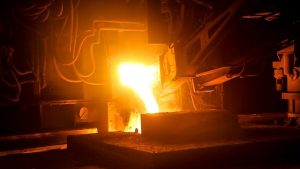
Casting is a metalworking process that involves pouring molten metal into a mold cavity. As the molten metal cools, it changes from a liquid to a solid state, at which point the newly created object — known as a casting — can be removed. While there are nearly a dozen different types of casting processes, however, they all can be categorized as either expendable or non-expendable.
What Is Expendable Mold Casting?
Expendable mold casting refers to any casting process in which the mold can not be reused. Casting molds are designed to hold molten metal, so they naturally experience a significant amount of stress. Iron, for instance, has a melting point of 2,800 degrees Fahrenheit. When poured into a mold cavity, the fiery-hot iron may damage or deform the cavity’s interior. Regardless of the type of metal used, though, all expendable mold casting processes are characterized by their non-reusable mold.
It’s important to note that the molds used in expendable mold casting aren’t necessarily discarded after use. Depending on the specific type of expendable mold casting process, as well as the material used in the process, the mold may be salvaged. After the casting has been removed, the mold is reformed.
Some of the most common expendable mold casting processes include the following:
- Sand molding
- Shell molding
- Investment molding
- Plastic molding
- Lost-foam casting
What Is Non-Expendable Mold Casting?
Non-expendable mold casting, as you may have guessed, refers to any casting process in which the mold is or can be reused. Some molds are stronger and better suited to withstand the hot temperatures of molten metal than others. If a mold is made of a metal, for instance, conventional wisdom should lead you to believe that it’s stronger than a mold made of foam. Foam molds are commonly used in the expendable casting process lost-foam casting. With lost foam casting, molten metal causes the foam to melt and evaporate. As a result, foam molds can’t be reused. Molds made of metal, on the other hand, can be reused multiple times.
Some of the most common non-expendable mold casting processes include the following:
- Permanent molding
- Die casting
- Centrifugal casting
- Continuous casting
- Semi-solid casting
In Conclusion
Mold casting processes are classified as either expendable or non-expendable, depending on whether or not the mold can be reused. With expendable casting, the mold can’t be reused. With non-expendable casting, the mold can be reused.
